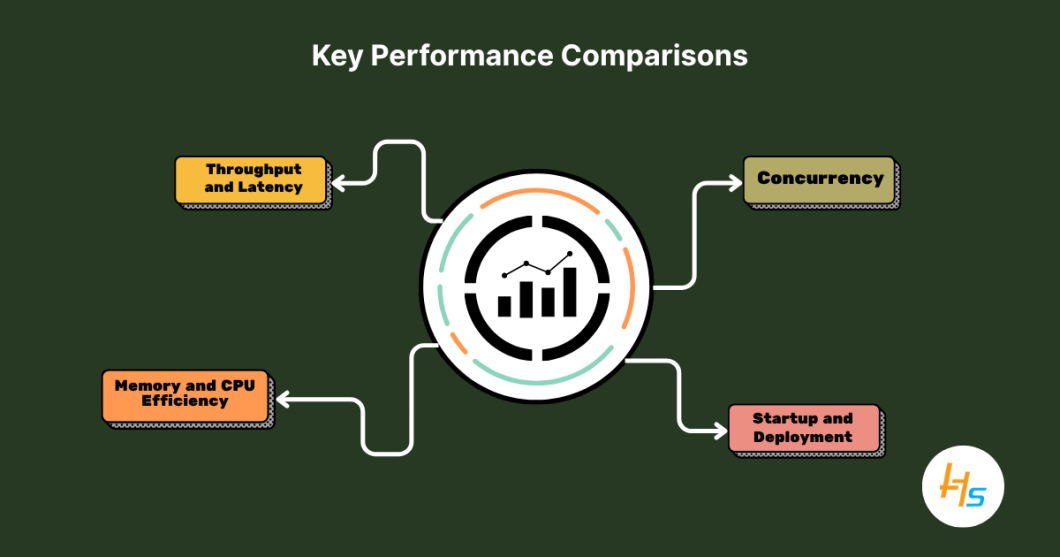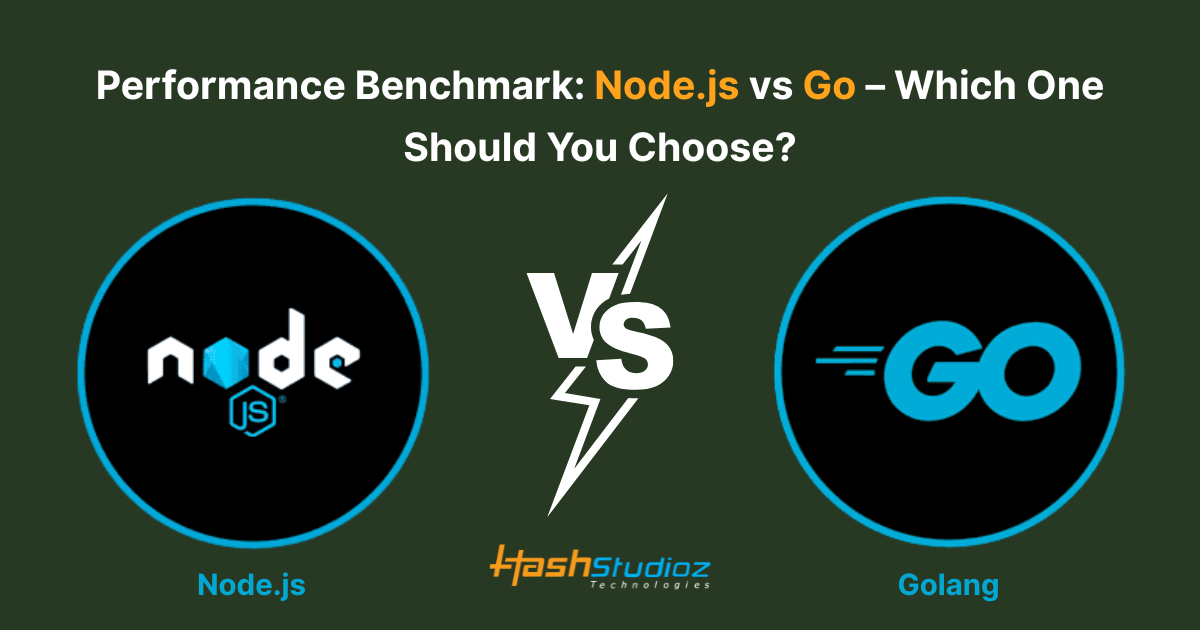In backend development today, performance, scalability, and efficiency matter more than ever. Two popular technologies—Node.js and Go (Golang)—power many modern systems. But how do they truly compare when put to the test in real-world applications? This article dives into Node.js vs Go Performance, examining the strengths and weaknesses of both.
Table of Contents
Overview Of Node.js and Go (Golang)
1. Node.js
Node.js is a runtime environment for executing JavaScript on the server side. Built on Chrome’s V8 engine, it uses a non-blocking, event-driven architecture, which makes it efficient for handling I/O-heavy tasks. It’s widely used for building APIs, real-time applications, and microservices in web development environments.
2. Go (Golang)
Go is a compiled, statically typed programming language developed by Google. Known for its simple syntax and powerful concurrency support via goroutines, it enables efficient parallel processing. Go is designed for high-performance, scalable backend systems and is often used in cloud-native applications, APIs, networking tools, and distributed systems.
Key Performance Comparisons

1. Throughput and Latency
- Go handles a higher volume of concurrent requests than Node.js : Go’s lightweight goroutines allow it to efficiently manage thousands of tasks at once. Unlike Node.js’s single-threaded event loop, Go can run many processes in parallel without significant performance drops. This ability makes Go ideal for backend systems requiring high concurrency and robust multitasking.
- Go maintains lower latency under load, making it better suited for high-traffic systems: Under heavy traffic, Go’s compiled nature and efficient concurrency model reduce response times and avoid bottlenecks. This consistent low latency helps maintain performance in demanding environments such as large-scale APIs, cloud services, and distributed applications where fast, reliable communication is critical.
2. Memory and CPU Efficiency
- Go is compiled to machine code, giving it better memory and CPU efficiency: Because Go compiles directly into machine code, it runs faster and uses less memory compared to interpreted languages. This compilation reduces runtime overhead and allows Go applications to perform efficiently, especially in resource-constrained environments or where high performance is essential for backend services.
- Node.js runs on the V8 JavaScript engine, which adds overhead and may require more resources: Node.js executes JavaScript using the V8 engine, which interprets code at runtime. This process introduces extra memory and CPU overhead, potentially increasing resource consumption. While this allows fast development, it can impact performance and efficiency, especially for CPU-intensive tasks or high-load applications.
3. Concurrency
- Node.js uses a single-threaded event loop, making it efficient for I/O-bound operations but less ideal for CPU-bound tasks.
Node.js handles input/output tasks efficiently through its event-driven, single-threaded model. This design excels at managing multiple simultaneous I/O operations but can struggle with heavy CPU processing, which may block the event loop and reduce overall performance under intensive computation. - Go uses lightweight goroutines, allowing it to execute thousands of concurrent tasks with minimal overhead.
Go’s concurrency model uses goroutines, which are lightweight threads managed by the Go runtime. These enable Go to run thousands of tasks concurrently with very low memory and CPU overhead, making it highly effective for scalable, parallel processing in complex backend systems.
4. Startup and Deployment
- Go binaries are compact and start quickly, making them perfect for serverless functions and microservices: Go compiles programs into small, standalone binaries that launch rapidly with minimal dependencies. This quick startup and lightweight footprint suit serverless environments and microservices architecture, where fast scaling and efficient resource use are critical for handling dynamic workloads and cloud-native deployments.
- Node.js provides faster development cycles, especially for teams using JavaScript across both frontend and backend: Node.js enables rapid application development, benefiting teams already skilled in JavaScript. Its vast ecosystem and flexibility allow developers to write, test, and deploy code quickly, making it an excellent choice for full-stack development, prototyping, and projects requiring fast iteration and frequent updates.
Use Case Recommendations
| Scenario | Recommended Choice | Reason |
| Real-time applications (e.g., chat apps) | Node.js | Strong WebSocket support and rich JavaScript ecosystem |
| High-performance APIs/backend services | Go | Low latency, high throughput, and efficient execution |
| Rapid prototyping / MVPs | Node.js | Faster development with npm and broad library support |
| Scalable microservices / infrastructure | Go | Superior concurrency and memory efficiency |
Developer Experience
1. Node.js
- Easy adoption for developers familiar with JavaScript: Node.js is easy to learn for developers who already know JavaScript. This familiarity reduces onboarding time and helps teams quickly build and maintain applications, making it a popular choice for startups and projects that require fast development cycles.
- Large and active ecosystem (npm): Node.js benefits from npm, one of the largest package repositories. Thousands of open-source libraries and tools are available, enabling developers to quickly add functionality, fix issues, and accelerate development without building everything from scratch.
- Great for full-stack development using the same language across frontend and backend: Using JavaScript for both frontend and backend with Node.js simplifies development. This unified language approach improves code reuse, team collaboration, and maintenance, making it ideal for projects that need fast iteration and seamless integration across the entire stack.
2. Go (Golang)
- Clean, simple syntax with great tooling: Go offers a straightforward syntax that’s easy to read and write. Its excellent tooling, including built-in formatting and testing, helps developers maintain clean, efficient, and reliable codebases throughout the project lifecycle.
- Built-in concurrency support: Go has native concurrency support through goroutines and channels. This allows developers to write efficient, parallel programs without external libraries, making it ideal for scalable, high-performance applications.
- More opinionated but results in consistent codebases: Go enforces specific coding styles and practices, which may feel restrictive but ensures uniform, maintainable code. This opinionated approach reduces debates and inconsistencies in team projects, improving long-term code quality.
- Slightly steeper learning curve for beginners: While Go is simple compared to many languages, its concurrency model and strict typing present challenges for newcomers. Beginners may need extra time to master these concepts but gain strong programming fundamentals as a result.
Work With Certified Backend Experts at HashStudioz
If you’re still unsure which technology fits your project best—Node.js or Go—you don’t have to make the decision alone. HashStudioz offers dedicated consulting and development teams skilled in both platforms. Whether you need to build high-performance APIs in Go or create scalable real-time applications with Node.js, we provide end-to-end backend solutions tailored to your business goals.
Services we offer:
- Performance-optimized backend development in Go and Node.js
- Migration of legacy systems to modern, scalable architectures
- Microservices and cloud-native system design
- Code audits, optimization, and long-term support
Ready to scale your backend with expert support?
Hire certified Node.js and Go developers from HashStudioz and get high-quality, production-ready solutions built to last.
Conclusion
There’s no single best choice between Node.js and Go. Choose Go if your focus is performance, concurrency, and scalability, especially for microservices and data-heavy systems. Pick Node.js for faster development, flexibility, and full-stack JavaScript use. Both are reliable, production-ready technologies. Your decision should depend on your application needs, team expertise, and long-term scalability and maintenance plans.

